Community Payphones of the World
The Payphone Project collects stories, pictures and phone numbers of pay phones from around the world.
Among their collection are these three representative payphones.
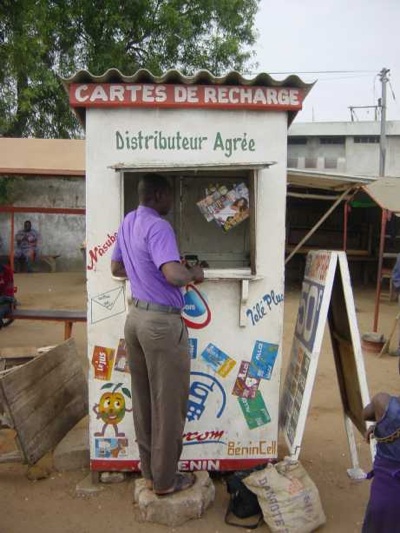
Community phone booth in Cotonou, Benin.
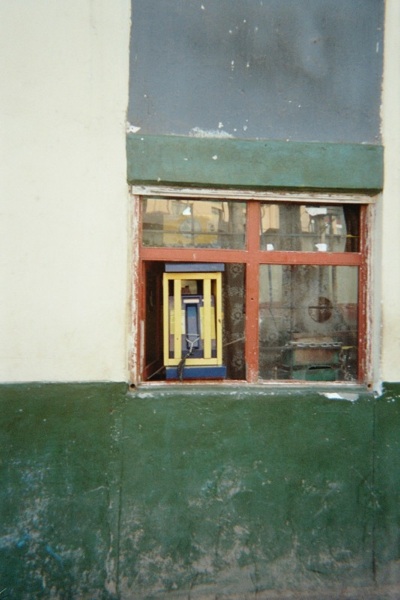
Pay phone chained to the window of a store in Cuzco, Peru.
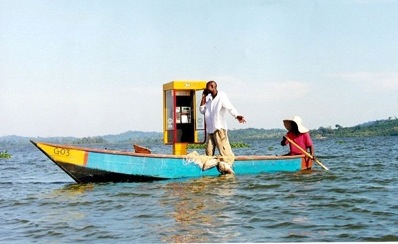
Payphone on Lake Victoria in Uganda using GSM Technology and Solar Power. Photo sent in by Craig Wheeler, Remkor Technologies South Africa.
Matching Cardboard Luggage
This guy has discovered several important facts. 1) If you wrap anything in cheap packaging tape, it is almost indestructible. And 2) Matching luggage makes you look very chic. This fellow, photographed in Manhattan by Street Use reader Michael Krakovskiy, accomplishes both goals at once. He’s made his own extremely useful matching luggage from cardboard and tape.
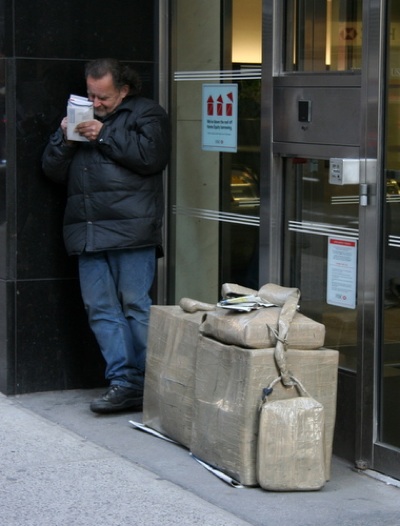
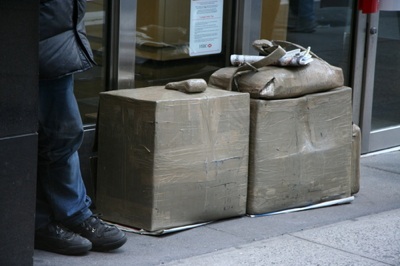
Jazz on Bones: X-Ray Sound Recordings
In the USSR and Eastern Europe in the 1950s underground night spots would play music pirated from the west. The only media they had were recorders etched into discarded X-ray film. I’ve long sought some images. Researcher Camille Cloutier pointed me to these, collected and posted by József Hajdú. Here’s what he says about them:
During the late 1930s and early 1940s the prevalent sound recording apparatus was the wax disk cutter. As a consequence of the lack of materials in the war-time economy, some inventive sound hunters made their own experiments with new materials within their reach.

I do not know the name of the inventor who first utilized discarded medical X-ray film as the base material for new record discs; however, the method became so widespread in Hungary that not only amateurs, but the Hungarian Radio made sound recordings on such recycled X-ray films.
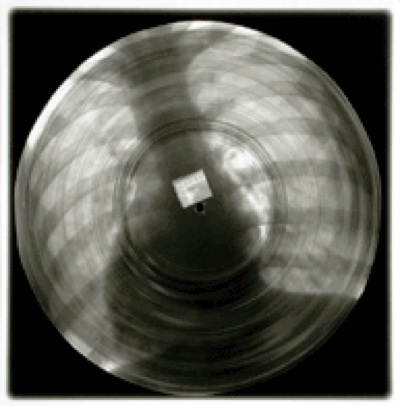
I felt that those X-ray record albums relate to our contemporary lives in many ways, especially when considering such terms as ‘multimedia’ or ‘recycling’. I copied the X-ray films with their engraved sound-grooves on photosensitive paper and made enlargements of certain details.
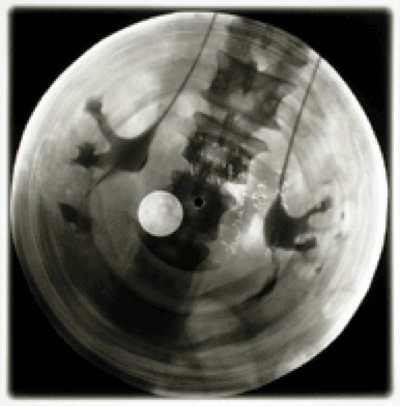
I was quite lucky to find a considerable amount of similar sound records in private collections. These are also interesting from the visual aspect. By utilizing different photographic processes, I created from them pictures meant to be exhibited in galleries.
In an online paper called The Historical Political Development of Soviet Rock Music, Trey Drake, at the University of California, Santa Cruz, offers further historical perspective on this street use of technology:
Owing to the lack of recordings of Western music available in the USSR, people had to rely on records coming through Eastern Europe, where controls on records were less strict, or on the tiny influx of records from beyond the iron curtain. Such restrictions meant the number of recordings would remain small and precious. But enterprising young people with technical skills learned to duplicate records with a converted phonograph that would “press” a record using a very unusual material for the purpose; discarded x-ray plates. This material was both plentiful and cheap, and millions of duplications of Western and Soviet groups were made and distributed by an underground roentgenizdat, or x-ray press, which is akin to the samizdat that was the notorious tradition of self-publication among banned writers in the USSR. According to rock historian Troitsky, the one-sided x-ray disks costed about one to one and a half rubles each on the black market, and lasted only a few months, as opposed to around five rubles for a two-sided vinyl disk. By the late 50’s, the officials knew about the roentgenizdat, and made it illegal in 1958. Officials took action to break up the largest ring in 1959, sending the leaders to prison, beginning an orginization by the Komsomol of “music patrols” that later undertook to curtail illegal music activity all over the country.
From Artemy Troitsky’s Back in the USSR: The True Story of Rock in Russia (1987, Omnibus Press):
The demand for pop and jazz recordings at the end of the fifties and beginning of the sixties was already enormous, while records and tape recorders were in catastrophically short supply. This led to the birth of a legendary phenomenon — the memorable records ‘on ribs.’ I myself saw several archive specimens.
These were actual X-ray plates — chest cavities, spinal cords, broken bones — rounded at the edges with scissors, with a small hole in the centre and grooves that were barely visible on the surface. Such an extravagant choice of raw material for these ‘flexidiscs’ is easily explained: X-ray plates were the cheapest and most readily available source of necessary plastic. People bought them by the hundreds from hospitals and clinics for kopeks, after which grooves were cut with the help of special machines (made, they say, from old phonographs by skilled conspiratorial hands).
The ‘ribs’ were marketed, naturally, under the table. The quality was awful, but the price was low — a rouble or rouble and a half. Often these records held surprises for the buyer. Let’s say, a few seconds of American rock’n’roll, then a mocking voice in Russian asking: “So, thought you’d take a listen to the latest sounds, eh?”, followed by a few choice epithets addressed to fans of stylish rhythms, then silence.
Both the shtatniki and beatnicki were few in number and their heyday was brief. The imitative, decorative style and American mannerisms they cultivated were way out of place in the early sixties, when Soviet youth was full of euphoric enthusiasm over the fliht of Yuri Gagarin, the Cuban revolution, and the programme proclaimed by Khruschev at the 22nd Party Congress wherein Communism would be achieved within the next two decades. Decadence and disaffection were completely out of style.
I’d love to find out more about this street use. Pointers welcomed.
Chrysler Motel
Friend and Street Use reader Todd Lapin sent this nice catch along. It’s an old Chrysler converted to residential mobile housing. He says it’s been an inhabitant of the SF waterfront near Islais Creek for years. If you are going to live in your car parked on a public street, why not alter it so it gives the maximum comfort and privacy? He writes in his Telstar Logistics blog:
“This 1960s-era Chrysler station wagon has been given a remarkable DIY residential conversion. It isn’t used for weekend trips; the owner lives in it full time. That explains why there are so few windows, and why there’s a big skylight on the roof — fewer street-level windows means far more shelter from prying eyes. We’ve seen this car a lot over the years, and we’ve noticed that it moves frequently, but never far, within the waterfront district.”

Rooftop and Building Sides Theaters
This is literally street use of technology. Projecting films for the neighborhood at night is not a new idea, but hi-tech digital projectors make it possible on a much smaller scale. In New York City a group called Rooftop Films will rent equipment or help communities set up movie projections during warm summer nights. But anyone with a cheap digital projector can do their own show in their own neighborhoods. You need a large white wall or screen, a projector, DVD player, sound, lots of chairs and a warm night.
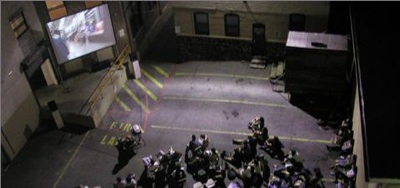
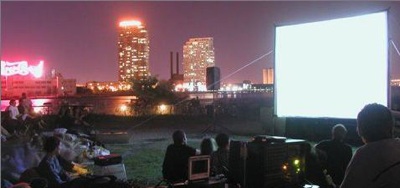
Beach Sandal Curtain
A large part of street use is recycling one product into another product. Often the new product is lightyears away from the notion of the designers of the original product. In Nairobi, Paul Merrill found this bead curtain made up of plugs from the soft foam in the soles of flip-flops. Flip-flop sandals are the standard issue shoe in much of Africa. Since they are so lightweight and wear out fast, they are constantly being lost or discarded. They wash up on the beach in large numbers. Here’s Paul’s collection from one morning’s walk:
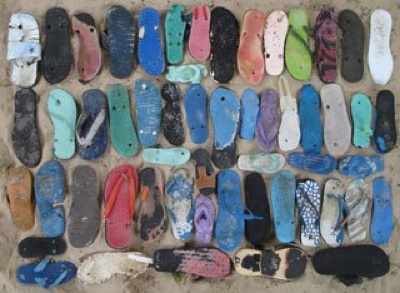
But someone figured out they could be harvested to make a colorful bead curtain for only the cost of string.
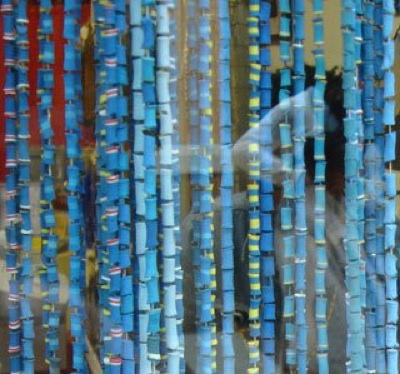
Quick Public Showers
These makeshift showers were seen at the International Triathlon 2006, Marina Bay, Miri, Sarawak, Malaysia. Photo by Sharon.

Rice Sack Sails
Sails sewn from used rice sacks found on a boat sailing up the Niger in Mail between Mopti and Timbuktu. Photo by Crazyrabbit.

Makeshift Latch
Problem: wind blows door open in old hut. Solution: improvise a latch using metal grills and extension cord. This apparent hack was found in a hut apparently used by vagrants. Post on Flickr by Tak.
From the inside it looks like this.
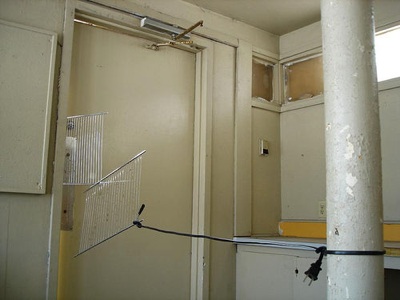
From the outside, we can see how the latch holds.
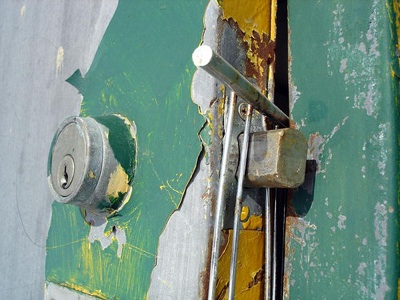
Makeshift Bomb Trigger
I found a few more examples of makeshift bomb triggers from Iraq. A soldier named Chris Heathscott posted this picture on the Black Five site. As they state: “Soldiers from the 39th Brigade Combat Team recently hit the jackpot in Taji, Iraq. After some intense fighting, they nabbed a terrorist leader and cache of weapons and items used for IEDs (Improvised Explosive Device). One type of trigger device found was a cell phone rigged up to a motorcycle battery which allows the trigger to remain operational for an extended period.”
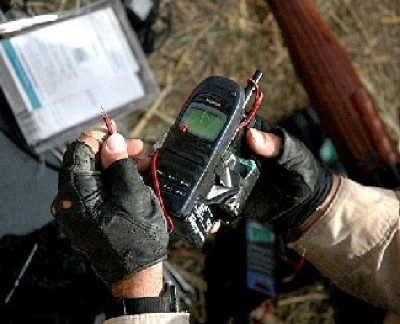
I don’t know much about the second image:



